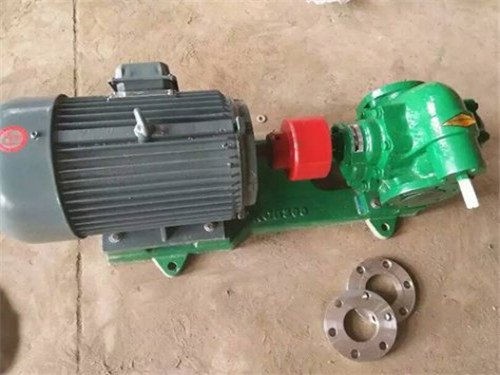Gear oil pump series
High viscosity pump series
Centrifugal pump series
Pump series for other purposes

KCB series gear pump
The KCB series gear pump is a traditional product in China, and its structure and design were introduced to the Soviet Union in the early 1950s. It has the characteristics of simple structure, practicality, and convenient use and maintenance. The KCB series gear pumps are equipped with protective valves. When the KCB gear pump is overloaded, it automatically opens to protect the motor, but cannot be used as a normally open relief valve to regulate the working pressure of the pump.
The KCB gear oil pump products produced by our factory with specifications above KCB-200 have changed the protection valve to an overflow valve, which can adjust the working pressure of the pump within the rated pressure range. There is no need to install additional components such as overflow valves on the pipeline, providing a dual function of regulation and overload protection.
The KCB series gear pump is composed of a three jaw elastic coupling and a motor to form the entire oil pump.
The KCB series gear pump is commonly used for conveying oil media at room temperature (below 120 ℃), without corrosion, containing no solid particle impurities and fibers, for pressurization, and as a lubricating pump in various mechanical equipment thin oil stations. By reducing the pump speed, it can transport high viscosity heavy oil media in the form of fluids.
The KCB series gear pump is suitable for conveying lubricating oil or other liquids with properties similar to lubricating oil, which does not contain solid particles and fibers, is non corrosive, has a temperature not exceeding 120 ℃, and a viscosity of 5 × 10-6~1.5 × 10-3m2/s (5-1500cSt).
● Application scope
KCB gear oil pump can be used as a transmission and booster pump in oil transportation systems;
KCB gear pump can be used as a fuel pump for conveying, pressurizing, and injecting in fuel systems;
A hydraulic pump that can be used to provide hydraulic power in hydraulic transmission systems;
KCB gear pumps can be used as lubricating oil pumps in industry;
● Structural characteristics
The KCB series gear pump mainly consists of gears, shafts, pump bodies, protective valves, and shaft end seals. The gears have high hardness and strength after heat treatment, and are installed together with the shaft in a replaceable shaft sleeve for operation. The lubrication of all parts inside the KCB gear oil pump is automatically achieved using the output medium during pump operation.
There are oil discharge and return grooves inside the pump, which cause the gear to bear less torque force during operation, resulting in less bearing load and wear. KCB gear oil pump.
The KCB gear pump is equipped with a protection valve as overload protection. The total reflux pressure of the protection valve is 1.5 times the rated discharge pressure of the pump. The KCB gear pump can also be adjusted within the allowable discharge pressure range according to actual needs. However, please note that this protective valve cannot be used as a pressure reducing valve for long-term operation. If necessary, it can be installed separately on the pipeline.
From the extended end of the spindle towards the pump, it rotates clockwise.
The KCB series gear pump is an important component that elevates the low-pressure oil in the fuel tank to the high-pressure oil that can perform work through the rolling meshing of a pair of involute gears with the same parameters and structure. It is a power device that converts the mechanical energy of the engine into hydraulic energy. The following faults are prone to occur during its use.
1. Wear of internal parts of KCB gear oil pump
Wear of internal parts of the oil pump can cause internal leakage. The large leakage area between the floating shaft sleeve and the gear end face is the main cause of internal leakage. This part of the leakage accounts for about 50% to 70% of the total internal leakage. The volumetric efficiency of gear pumps with wear and internal leakage decreases, and the output power of the oil pump is lower than the input power. All of its losses are converted into thermal energy, which can cause the oil pump to overheat. If the joint plane is pressed tightly, the floating shaft sleeve will have a slight movement during operation, causing wear and tear, resulting in slow or ineffective lifting of agricultural tools. Such floating shaft sleeves can be replaced or repaired.
2. KCB gear oil pump oil seal is worn and the seal is aging
The rubber oil seal of the unloading plate has aged and deteriorated, losing its elasticity, and losing its sealing and isolation effect on the high-pressure and low-pressure oil chambers. This can cause oil pressure from the high-pressure oil chamber to flow into the low-pressure oil chamber, known as "internal leakage", which reduces the working pressure and flow rate of the oil pump. The normal working pressure of the CB46 gear pump is 100-110kg/square centimeter, the normal oil delivery rate is 46L/min, and the standard unloading plate rubber oil seal is 57 × 43. Self tightening oil seal is a PG25 × 42 × 10 skeleton oil seal. If it is damaged or fails for a long time, air will be sucked into the oil pump from the gap between the oil seal and the main shaft journal or from the joint between the oil inlet connecting plate and the oil pump housing, and enter the oil tank through the return oil pipe, generating a large number of bubbles in the oil tank. It will cause a decrease in oil in the tank and an increase in oil in the engine oil pan, resulting in slow or ineffective lifting of agricultural tools. Replacing the oil seal can eliminate this fault.
3. Wear of oil pump housing
Mainly due to the wear of the floating shaft sleeve hole. The gear works under the pressure of oil, and the tip of the gear is close to the oil pump housing, causing wear on the low-pressure chamber of the pump body. Another type of wear is the circumferential wear of the working surface inside the shell, which is mainly caused by impure oil added, so an oil without impurities is added.
4. Insufficient or no oil pressure from the oil pump
Phenomenon: The working device lifts slowly, shaking or unable to lift during lifting; There are bubbles in the fuel tank or oil pipe; When lifting, the hydraulic system emits a "chirp" sound; When the tractor is first started, the working device can be lifted. After working for a period of time and the oil temperature rises, the lifting is slow or cannot be lifted; It can be increased under light loads, but cannot be increased under heavy loads.
Cause of malfunction:
(1) The oil level of the hydraulic oil tank is too low;
(2) Not using hydraulic oil according to seasons;
(3) The oil inlet pipe is severely blocked by dirt;
(4) The oil seal of the driving gear of the oil pump is damaged, and air enters the hydraulic system;
(5) The O-ring seal of the oil pump inlet and outlet joints or bent joints is damaged, the fastening bolts or inlet and outlet pipe nuts of the bent joints are not tightened, and air enters the hydraulic system;
(6) Internal leakage of oil pump and aging of sealing ring;
(7) The oil pump end face or the main and driven gear shaft sleeve end face are worn or scratched, and the unevenness of the two shaft sleeve end faces exceeds the tolerance;
(8) Internal leakage caused by incorrect assembly of internal parts in the oil pump;
(9) Installing a left-handed and right-handed oil pump causes damage to the skeleton oil seal;
(10) Hydraulic oil is too dirty.
KCB series gear pump performance parameter table:
| model | flowQ | speed n r/min | Discharge pressure p Mpa | Cavitation marginr m | efficiencyη % | electrical machinery | ||
| m3/h | L/min | powerKW | model | |||||
| KCB-18.3 | 1.1 | 18.3 | 1400 | 1.45 | 5 | 44 | 1.5 | Y90L-4 |
| 2CY-1.1/1.45 | ||||||||
| KCB-33.3 | 2 | 33.3 | 1420 | 1.45 | 5 | 44 | 2.2 | Y100L1-4 |
| 2CY-2/1.45 | ||||||||
| kcb-55 | 3.3 | 55 | 1400 | 0.33 | 7 | 41 | 1.5 | Y90L-4 |
| 2CY-3.3/0.33 | ||||||||
| KCB-83.3 | 5 | 83.3 | 1420 | 0.33 | 7 | 43 | 2.2 | Y100L1-4 |
| 2CY-5/0.33 | ||||||||
| KCB-135 | 8 | 135 | 940 | 0.33 | 5 | 46 | 2.2 | Y112M-6 |
| 2CY-8/0.33 | ||||||||
| KCB-200 | 12 | 200 | 1440 | 0.33 | 5 | 46 | 4 | Y112M-4 |
| 2CY-12/0.33 | ||||||||
| KCB-300 | 18 | 300 | 960 | 0.36 | 5 | 42 | 5.5 | Y132M2-6 |
| 2CY-18/0.36 | ||||||||
| KCB-483.3 | 29 | 483.3 | 1440 | 0.36 | 5.5 | 42 | 11 | Y160M-4 |
| 2CY-29/0.36 | ||||||||
| KCB-633 | 38 | 633 | 970 | 0.28 | 6 | 43 | 11 | Y160L-6 |
| 2CY-38/0.28 | ||||||||
| KCB-960 | 58 | 960 | 1470 | 0.28 | 6.5 | 43 | 18.5 | Y180M-4 |
| 2CY-58/0.28 | ||||||||
| KCB-1200 | 72 | 1200 | 740 | 0.6 | 7 | 43 | 37 | Y280S-8 |
Selection and Application of Gear Pump Seals
Why is it necessary to seal a gear pump ? The sealing of a gear pump primarily occurs in tw ...
2025-09-24
Maintenance precautions for gear pumps transporting heavy oil
For the maintenance of gear pumps transporting heavy oil (such as fuel oil, residual oil, a ...
2025-09-17
Application scope and occasions of electric gear pump
Electric gear pump , as the name suggests, is a gear pump driven by an electric motor. It i ...
2025-09-10
Introduction to the advantages and disadvantages of gear pumps with electric heating tubes and asphal
Gear pumps with electric heating tubes and asphalt pumps with insulation layers are commonl ...
2025-09-03



